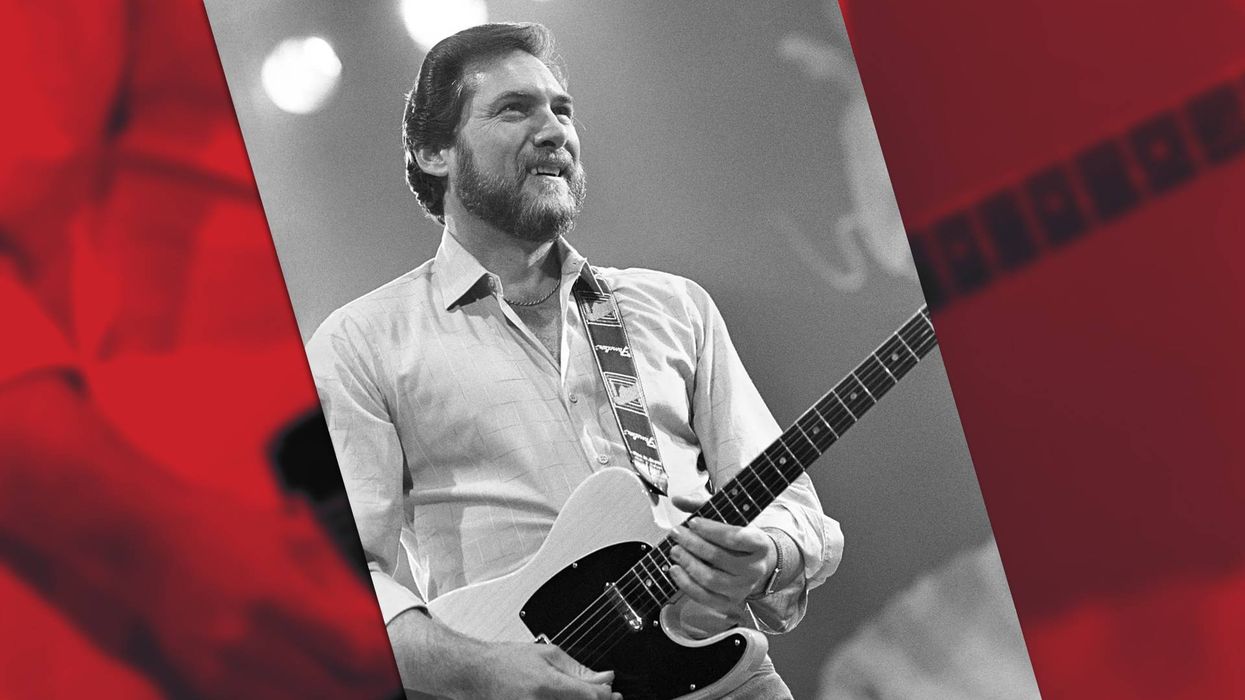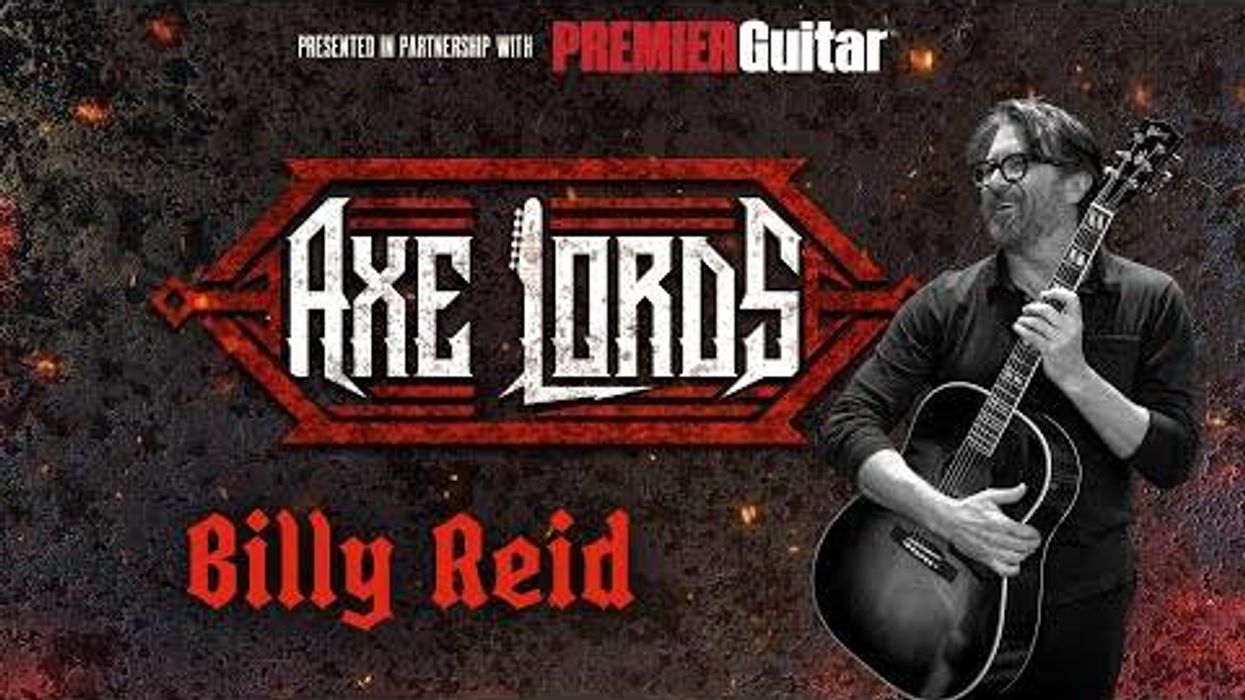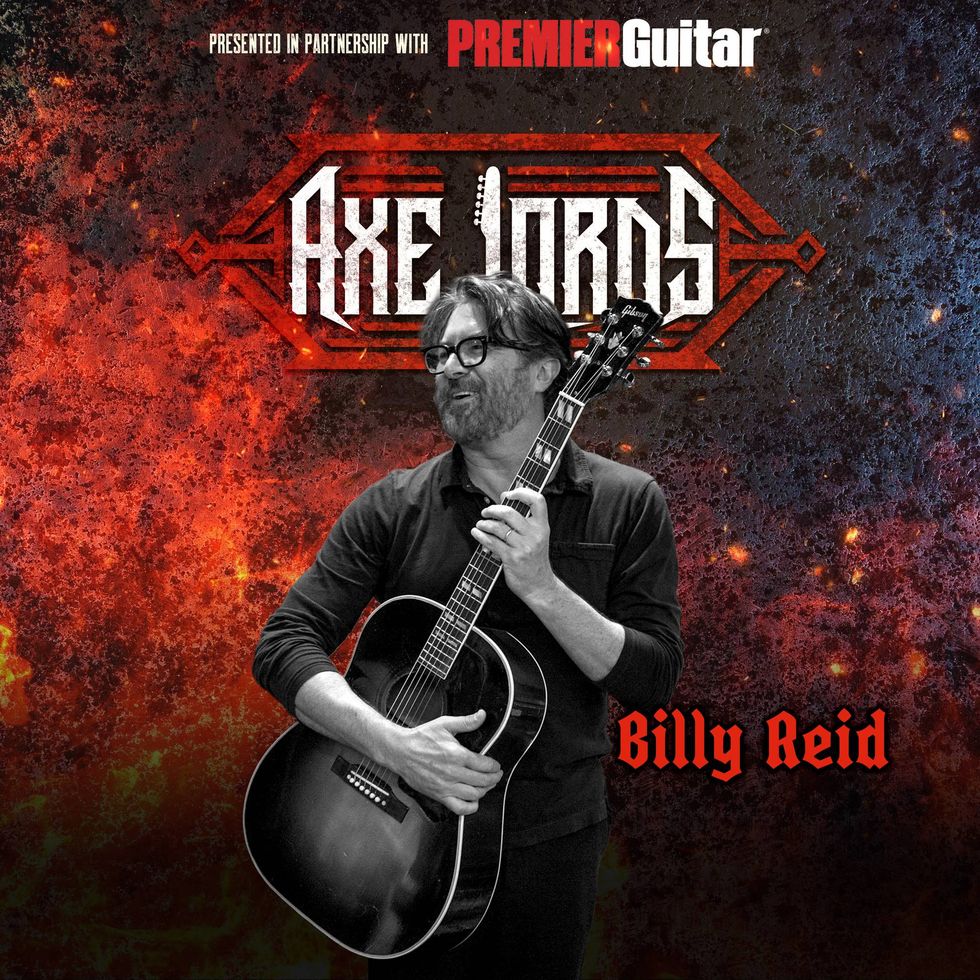The desert has captured the imaginations of so many guitarists. Throughout the modern history of our instrument, players have been enchanted by its mystery, stillness, or whatever they feel it represents. Those who’ve made the desert their muse, whether for a one-off project or lifelong dedication, interpret their feelings just as widely. From Grant Green’s funky settings of cowboy tunes on his Goin’ West to the slow, monolithic riffs of doom icons Earth, Ry Cooder’s lonely, plaintive slide work on the soundtrack for Wim Wenders’ Paris, Texas, to Saharan guitar masters Ali Farka Touré and Tinariwen, there is no one desert sound. Instead, there’s an ineffable feeling, a vibration that resonates across the quirkiest and the most severe of these projects.
For brothers Estevan and Alejandro Gutiérrez, it wasn’t until they’d travelled across the American Southwest that they realized how captivated they’d become. Raised by an Ecuadoran mother and Swiss father in Switzerland—a decent distance from any arid terrain—Estevan explains, “I think it’s just a feeling that we have. It’s just in us.” In 2018, a couple years after forming their duo, Hermanos Gutiérrez, they took a trip across through Death Valley and the Mojave Desert. “It just blew our minds.” he says. The brothers had never discussed musical influences, and their trip taught them their deepest musical truth. The desert, Estevan says, “is where our music was born.”
Hermanos Gutiérrez - "Los Chicos Tristes" [Official Music Video]
A few years have now passed, and the brothers are confident in their inspiration, which, on El Bueno Y El Malo—their fifth full-length release and their first on Dan Auerbach’s Easy Eye Sound—comes by way of classic film imagery. The album opens with the title track, its dramatic first strums serving as an overture that introduces listeners to the type of instrumental storytelling they’re about to hear in 10 short, simply stated chapters. By the middle of the record, Western analogies abound: “Tres Hermanos” feels like a three-way high-noon guitar showdown across the stereo field with Auerbach joining in, while the simple, major-key elegance of “Pueblo Man” radiates the morning sun, contrasting the minor-key chiaroscuro of the subsequent “La Verdad.” Together, the album makes for an enthralling listen, with a balance of instrumental plot and exposition in their simple chord progressions, ornate rhythms, and plainly stated melodies that appeals to the same sensibilities as some of Cormac McCarthy’s best novels.
Any of the songs on El Bueno Y El Malo could serve as more intimate stand-ins for Ennio Morricone’s soundtrack work, and throughout their body of work, the brothers’ music feels like a series of ready-made film scores. “On a personal level,” says Alejandro, “I always love to make a sound that brings you somewhere. Because we love the desert and the spaghetti Western kind of vibe, we’re telling a story that has this kind of a feeling.” He points to “big film scores” as an outsize influence, specifically Morricone’s work with director Sergio Leone. “Watching those movies without music,” he says, “it’s impossible. It just shows the power of music itself.” He goes on to call Neil Young’s score to Jim Jarmusch’s Dead Man “a milestone in film scores. It’s perfect.”
“The biggest thing you can hear on the record is the Easy Eye Sound, which sounds kind of hilarious, but it is. You enter this studio, and you can just feel it, you know?” –Estevan
It’s no surprise, then, that the Gutiérrezes talk at least as much in visual references as they do about musical ones. And as a touring act they’ve taken in a lot of firsthand stimuli. “Part of what we’re doing is travelling together as brothers,” says Alejandro, “so we go to places, we come back and we’re feeling inspired, and we feel like we’ve gotta write something about this place.”
Their relationship as brothers is the other essential part of their music. Around the age of 9, Estevan first picked up a guitar. He started by studying classical guitar and says he was a fan of “old music from Ecuador,” which he played into his teens. Once he took up surfing, he got into Jack Johnson, but says he “always stayed with my salsa roots.” Eight years younger, Alejandro saw the power of music in his brother’s hands for as long as he can remember. “Our mom always got emotional when he was playing that old milonga kind of music,” he says about “those Argentinian pieces which are so beautiful.”
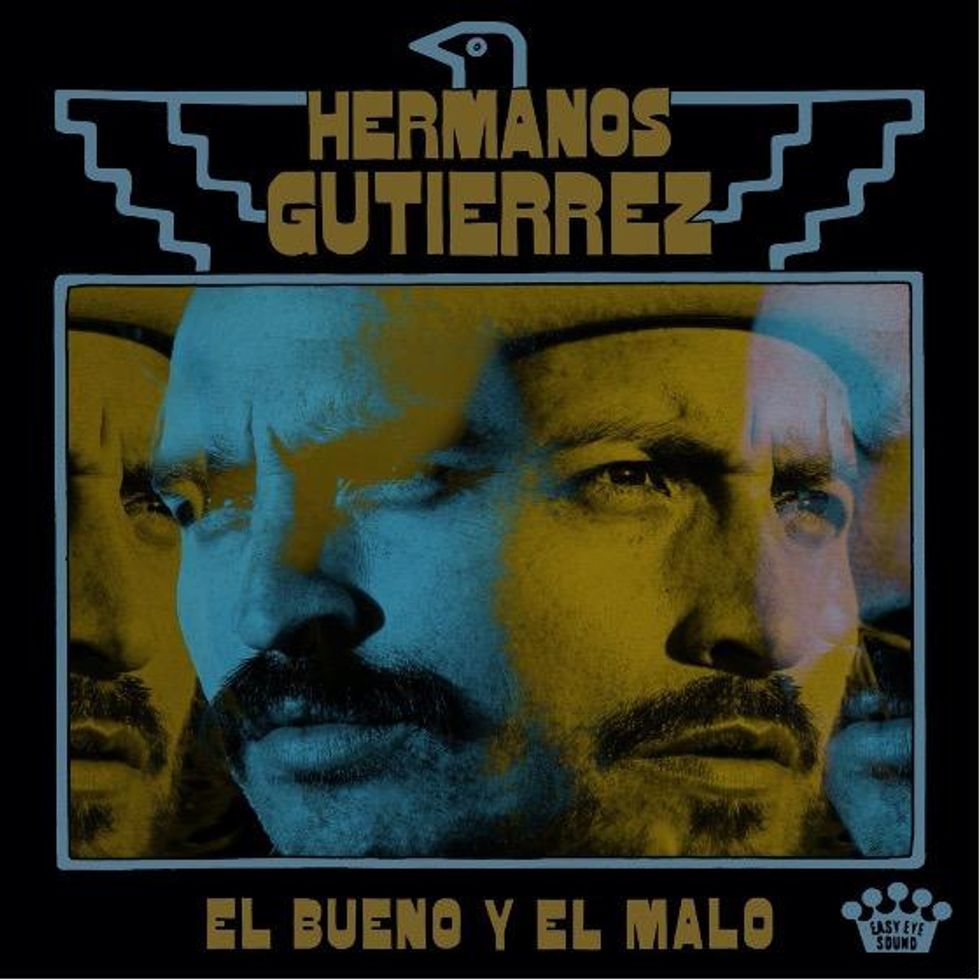
Working with Dan Auerbach and his stable of Nashville veterans, El Bueno Y El Malo marks the first time the brothers have collaborated with a producer or featured other musicians on an Hermanos Gutiérrez album.
In his 20s, Estevan moved to Ecuador to live with his grandparents. “I didn’t have a real plan,” he confesses. “I just went over, and I started to work in a salsa bar on the weekend.” There, he served drinks and worked security, spending the rest of his time surfing. “[It] was the best experience I ever had.”
Back in Switzerland, Alejandro picked up the guitar out of loneliness. “I just missed that sound in our house, so I started playing,” he explains. He started by teaching himself and, by 18, his parents gave him a classical guitar.
It wasn’t until just six years ago, when Alejandro moved to Zurich, that the brothers, once again living in the same place, started playing music together. “We were missing each other,” Alejandro explains. “Instantly, we were connecting through music.” Writing with just their electric guitars plugged direct into small amps—a Gibson CS-336 and a Fender Princeton Reverb for Estevan, and a Fender Stratocaster and Vox AC10 for Alejandro—he says they “always had this idea of having our own vinyl” because “it lasts forever, and you can pass it on to future generations.” In 2017, they recorded their debut, 8 Ãños.
Estevan Guttiérez’s Gear
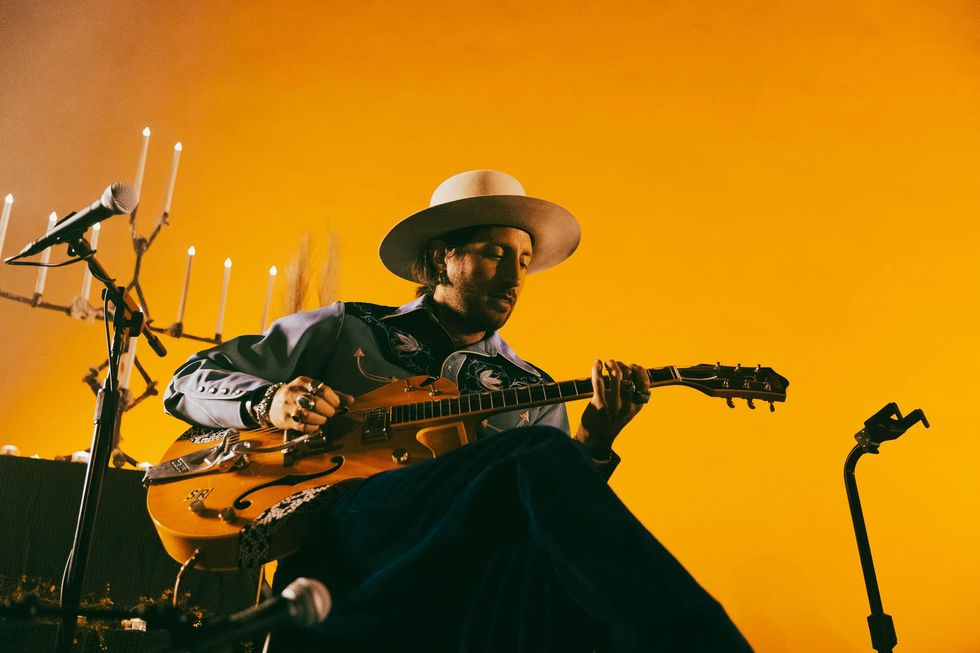
It wasn’t until the brothers took a trip through the American Southwest that they realized the desert was their muse. Estevan explains, “It just blew our minds.”
Photo by Debi Del Grande
Guitars
- Gibson CS-336
- Gretsch 6120
- 1959 Gretsch 6120 “Rudy” (at Easy Eye Sound)
Amps
- Fender Deluxe Reverb
- Fender Princeton Reverb
- Vintage Magnatone (at Easy Eye Sound)
Effects
- Boss TU-3 Chromatic Tuner
- MXR Dyna Comp
- Malekko Omicron Vibrato
- Strymon El Capistan
- Boss TR-2 Tremolo Analog Man mod
- Boss RC-300 Loop Station
Strings
- D’Addario EXL 115 (.011–.049)
Even on their first record, the Hermanos Gutiérrez established a strong, recognizable style. Estevan and Alejandro say their basic approach to writing and collaborating has never changed. “We have this invisible communication,” says Alejandro. “We don’t have to talk to each other that much. We feel it.” When writing, he explains, “we always know the other part is missing, this is the other brother’s part. We have this deep connection as brothers.” He adds that they never question their intuition. “We’re never looking for a particular sound or rhythm,” he says. “It’s never conceptual. It was never trying to have this sound. It’s just what it was.”
That’s not to say the project hasn’t evolved. Gear discoveries have helped them along their path. “When we started, we didn’t use any pedals,” says Estevan. “We just used the guitars and the amps. We were just two brothers playing guitar.” Eventually, Estevan discovered the Strymon El Capistan, a watershed that opened up creative possibilities. “I remember that day,” he reminisces about first playing the pedal. “I fell in love. I knew it was gonna change something in our sound.” As soon as he purchased the El Capistan, he says he called his brother and said, “You have to buy this. This is gonna be next level for us.”
“Part of what we’re doing is travelling together as brothers, so we go to places, we come back, and we’re feeling inspired, and we feel like we’ve gotta write something about this place.” – Alejandro
Part of the El Capistan’s allure, Alejandro explains, is that that they both found ways to approach the pedal differently. “I use it as a layer,” he explains. “Really subtle. My brother uses it more as a delay. He has this horse sound, like this galloping sound he can create with his slapping, which only he can do.”
That slapping is a percussive righthand technique that Estevan uses—not slapping of the funk variety. Rather, it’s the way he hits the strings when he’s strumming. Both Estevan and Alejandro are fingerpickers, which—and lots of credit to their classical-guitar backgrounds—means they have a variety of picking, strumming, and righthand attack techniques at their disposal. That includes using muted-string attacks for percussive effect, a relative of the early “bongo guitar” methods used by players such as Ray Crawford or Herb Ellis in drummer-less trio settings. While Alejandro credits his brother’s signature technique, they each do a variation on the move.
The Gutiérrezes’ rhythmic versatility casts a spell in live performance. There are few instrumental guitar duos out there who can make their audience dance and rock out. But when the Hermanos played Philadelphia in November, most of the near-capacity audience pulsed along with the music, with a small cohort breaking out into wavy, full-body interpretations.
Alejandro Guttiérez’s Gear
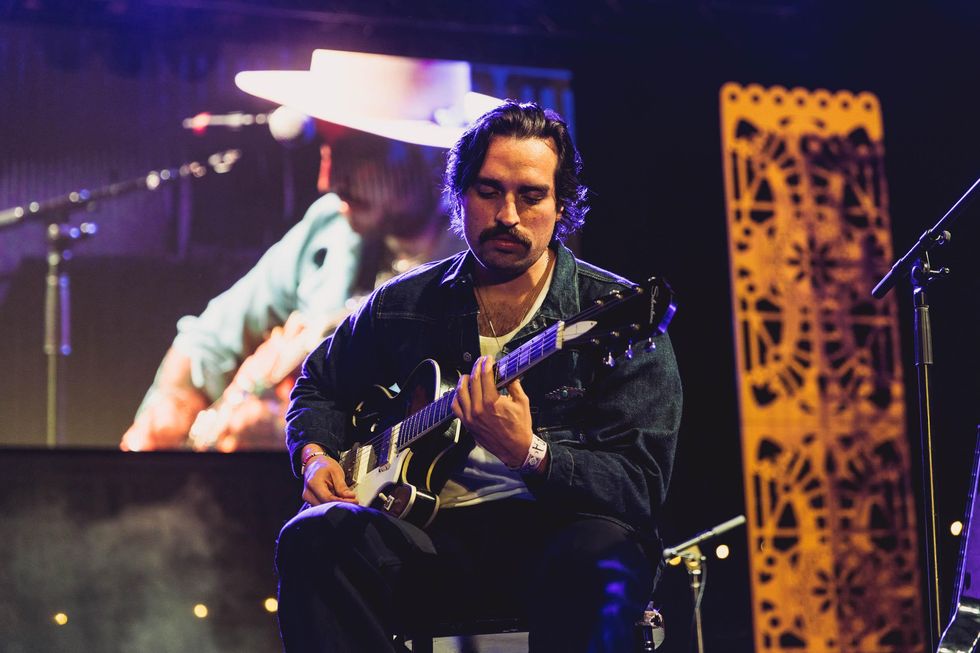
The brothers live in Switzerland, but they were back at Hollywood Forever for a Day of the Dead concert this fall. “Part of what we’re doing is travelling together as brothers,” says Alejandro, “so we go to places, we come back and we’re feeling inspired, and we feel like we’ve gotta write something about this place.”
Photo by Debi Del Grande
Guitars
- Fender Stratocaster
- Rickenbacker Electro NS lap steel
- Silvertone 1446
Amps
- Fender Deluxe Reverb
- Vox AC10
- Vintage Flot-A-Tone amp (at Easy Eye Sound)
Effects
- Boss TU-3 Chromatic Tuner
- Boss GE-7 Equalizer
- Ceasar Diaz Texas Tremodillo
- MXR Dyna Comp
- Strymon El Capistan
- Electro-Harmonix Freeze
Strings & Picks
- Pyramid Gold Heavy (.013–.052)
In concert, it’s just as easy to zoom in on the finer details in the brothers’ music as it is to vibe out on a wave of rhythm. Both Estevan and Alejandro sound as though they’re reproducing the most life-affirming classic guitar tones—mythical, old-school sounds, like they’re contemporaries of Santo and Johnny (another pair of guitar- and steel-playing brothers)—which will draw in any armchair historian of guitar music. Of course, that’s one thing to capture on record, which they do, but it’s another, more impressive thing to do with some rented Deluxe Reverbs. Within those sounds, there are sonic details to catch, like how nuanced Estevan’s right-hand patterns can get, or how Alejandro manages to pluck the string on his lap steel with his thumbnail—he eschews fingerpicks on lap steel as well—to add a bright attack to just the right notes. At the Philadelphia show, most of those who weren’t dancing slowly lurched closer to the duo until, near the end, the brothers were encircled on the World Café’s narrowly defined stage by listeners who were seemingly enraptured by these subtleties.
No doubt, though, it’s the brothers’ chemistry that ultimately makes them sound magical, no matter what a listener is focused on. For El Bueno Y El Malo, Auerbach was careful not to disrupt any of that energy. Upon arriving at Easy Eye Sound, he didn’t dissect how they’d approach the session with the duo. Instead, Auerbach simply let them do their thing. “We entered the studio,” says Alejandro, “and we were recording after 20 minutes.” As soon as they plugged into their amps, Auerbach made a few level adjustments around them while they got a feel for the studio. “We didn’t even realize,” he adds. “We looked at Dan and he said, ‘From the top again,’ and we were recording. That was ‘El Bueno Y El Malo,’ it was the first take.”
Although much has been written about Auerbach’s studio, including in PG, it bears repeating that the producer/guitarist has curated not just a fine collection of gear in Easy Eye Sound, but a vibe. “The biggest thing you can hear on the record,” points out Estevan, “is Easy Eye Sound, which sounds kind of hilarious, but it is. You enter this studio, and you can just feel it, you know? So, this mixed with all these vintage amps and guitars and our flavors that we put together, it was like a soup that we were cooking. It’s beautiful. You can hear it and it sounds so special.”
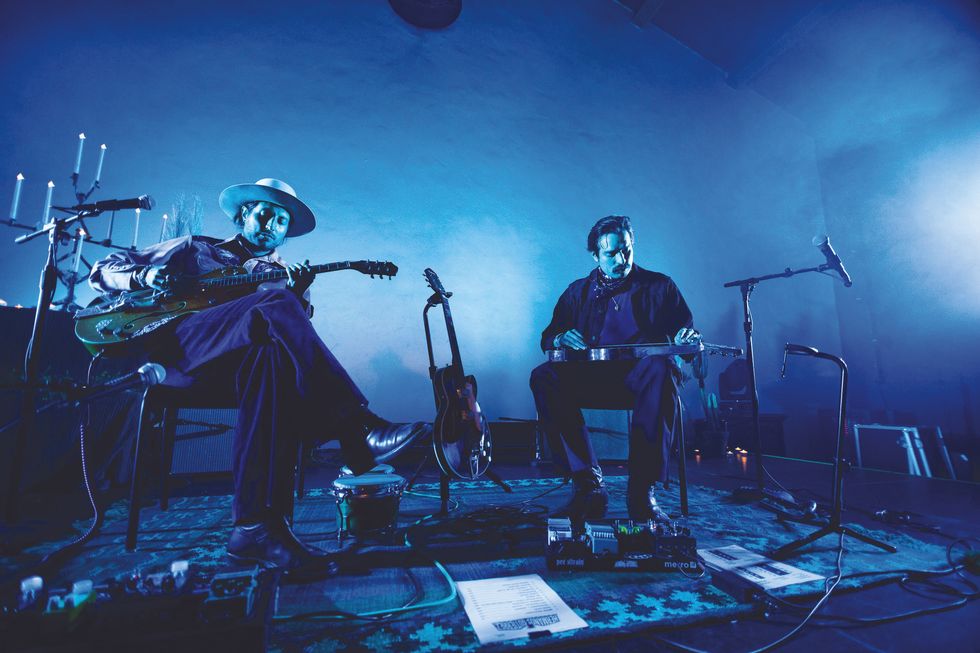
Brothers Estevan (left) and Alejandro (right) Gutiérrez at the Hollywood Forever Cemetery in May 2022.
Photo by Debi Del Grande
At Easy Eye, Alejandro used the house Flot-A-Tone amp and Estevan opted for a vintage Magnatone. He points out that the amp’s heralded vibrato is noticeable on the title track. Alejandro brought along his own vintage Silvertone 1446 and his Rickenbacker Electro NS lap steel—which he tunes by ear to each song, though he notes that he doesn’t keep track of his tunings. While Estevan brought his own modern Gretsch 6120, Auerbach offered his own 1958 Gretsch 6120, “Rudy,” which was too good to resist, and he used as his primary instrument for the record.
The duo finished their parts in just two and a half days, using several first takes. “We were not rushing things at all,” says Alejandro. “It was just really flowing perfectly.” With more time planned for the session, the brothers, who’d never worked with other musicians on their records, had plenty of ideas for how they would take advantage of Auerbach’s connections, and they brought in percussion, string, and organ players for overdubs.
“It’s never conceptual. It was never trying to have this sound. It’s just what it was.” –Alejandro
“It was so beautiful to work with these kinds of musicians,” says Estevan. “Everyone is on a high level. We felt like this is the right place for us.” Although other Auerbach productions might feature old-school session cats ripping solos and contributing key riffs, the additional production on El Bueno Y El Malo simply adds color and amplifies the magic that is already there. Auerbach and company deliver the perfect Easy Eye treatment—all ears are on the brothers.
With El Bueno Y El Malo, coming to Nashville to record has added to the brothers’ ongoing musical travelogue. Having come this far, it’s no surprise that the album stands as a major aesthetic statement for instrumental guitar music, and the definitive statement of Hermanos Gutiérrez. At least for now. When we spoke, they were getting ready for their U.S. tour, which would end in the Southwest. Both brothers acknowledged this trip would be a return to the source of their musical inspiration, a full-circle experience they were looking forward to. “It’s just beautiful where we can go with this music,” says Alejandro. “It’s just my brother and I together, and we’re so happy to have this.”
YouTube It
With a pair of hollowbodies in hand, Estevan and Alejandro seem to manifest the history of electric-guitar music in this intimate live taping of “El Bueno Y El Malo.”


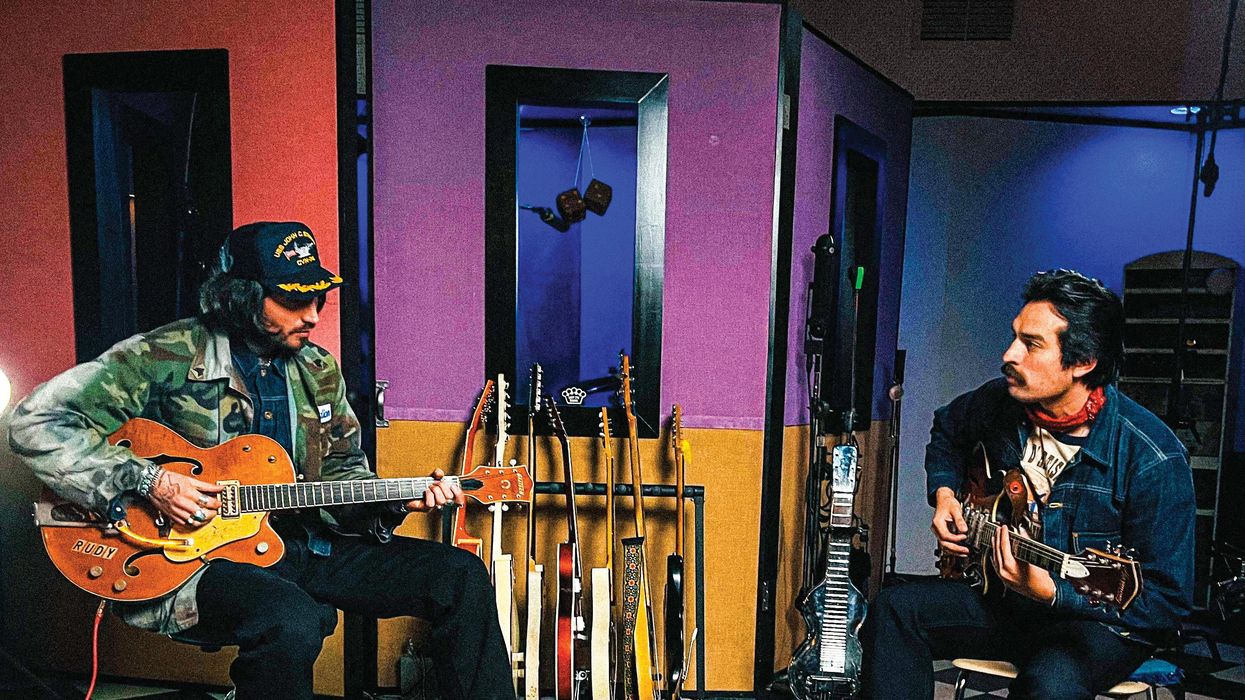












![Rig Rundown: Russian Circles’ Mike Sullivan [2025]](https://www.premierguitar.com/media-library/youtube.jpg?id=62303631&width=1245&height=700&quality=70&coordinates=0%2C0%2C0%2C0)






